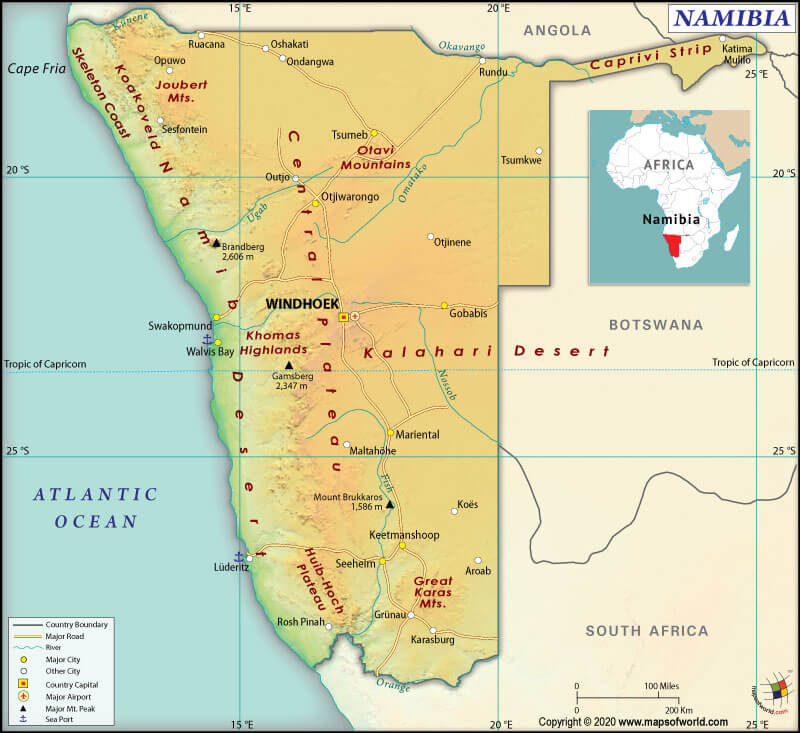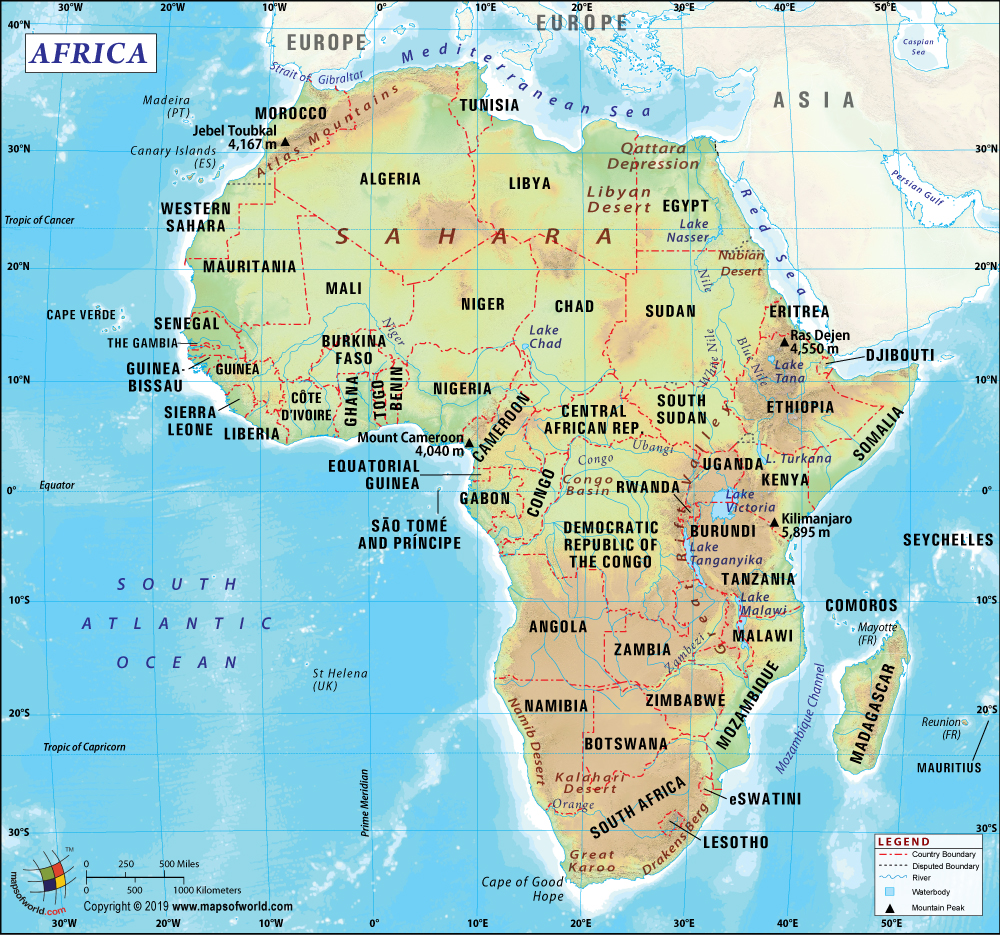What are the Key Facts of Namibia?

|
Official Name |
Republic of Namibia |
|
Continent |
Africa |
|
Capital |
Windhoek |
|
Largest City |
Windhoek |
|
Coordinates |
-22.000000, 17.000000 |
|
Area |
318,260 sq. mi (824,292 sq. km) |
|
Land Boundaries |
2,622 mi (4,220 km) |
|
Coastline |
977 mi (1,572 km) |
|
Currency |
Namibian dollar (NAD), South African rand (ZAR) |
|
Neighboring Countries |
Angola, Botswana, South Africa, Zambia |
|
Population |
2,494,530 (World Bank, 2019) |
|
Official Languages |
English (official), Oshiwambo languages, Nama/Damara, Kavango languages, Afrikaans, Herero languages, Zambezi languages |
|
Major Religion |
Christianity |
|
National Day |
21 March (Independence Day) |
|
National Anthem |
“Namibia, Land of the Brave” |
|
Form of Government |
Presidential republic |
|
President |
Hage Geingob |
|
Vice-President |
Nangolo Mbumba |
|
GDP per capita (PPP) |
$ 10,036.6 (World Bank, 2019) |
|
GDP per capita (nominal) |
$ 4,957.5 (World Bank, 2019) |
|
HDI |
0.645 (2019), Rank: 130 |
|
Literacy Rate (%) |
91.53 (UNESCO, 2018) |
|
Space Agency |
NA |
|
Military Expenditure Ranking |
93 (SIPRI, 2019) |
|
No. of Olympic Medals |
4 (as of 2018) |
|
Driving Side |
left |
|
Calling Code |
264 |
|
Time Zone |
UTC+2 (CAST) |
|
Internet TLD |
.na |
Where is Namibia?
Namibia (whose official name is the Republic of Namibia) is a South African country located between Angola and South Africa, bordering the South Atlantic Ocean.
What is the Geography of Namibia?
Namibia spread across a total area of 824,292 sq. km (318,260 sq. mi). Out of the total area, 823,290 sq. km (317,874 sq. mi) is land, and 1,002 sq. km (386 sq. mi) is water.
Here is Namibia Physical Map showing all physical feature of the country.
The total land boundary of Namibia is 4,220 km (2622.2 mi) long, which is shared with four countries: Botswana (1,544 km or 959.4 mi) to the east, Angola (1,427 km or 886.7 mi) to the north, South Africa (1,005 km or 624.5 mi) to the south and east, and Zambia (244 km or 151.6 mi) to the north.
Though the country doesn’t share a border with Zimbabwe, the two countries are separated by the Zambezi River (whose width is less than 200 meters or 660 feet). Namibia has a 1,572 km (976.8 mi) long coastline.
The mean elevation of the country is 1,141 m (3743.4 ft). While the highest point is Konigstein on Brandberg at 2,573 m (5065.6 ft), the lowest point is the Atlantic Ocean at 0 m (0 ft).
Namibia’s terrain is characterized mainly by high plateaus. However, other important landforms in the country are the Kalahari Desert in the east and the Namib Desert along the coast.
You will find a flat, sandy area on the northern border with Angola. It is called Bushveld, which includes one of the world’s most incredible wildlife-viewing spots, the Etosha National Park. Lake Otjikoto, one of the two natural lakes of Namibia, is located in this landform.
There are two deserts in the country: the Namib Desert and the Kalahari Desert. The Namib Desert, one of the oldest deserts of the world that dates back 43 million years, runs along the Skeleton Coast. It is characterized by looming dunes in a wide array of hues from apricot to maroon. The Kalahari Desert encompasses the inland expanse of Namibia, which is shared with Botswana and South Africa.
The Fish River is the longest in the country, which is 403 miles (649 km) long. This river dries up completely when out of season. The Fish River Canyon is Africa’s largest and world’s second-largest canyon. It is 99 miles (159 km) long and 17 miles (27 km) wide.
The Zambezi Region (formerly called Caprivi) is the wetland in the country. It is a fertile strip of land, which is situated in the far northeast of Namibia bordering the Zambia and Zambezi. The Zambezi Region consists of lush forest, swamps, and wide-array flora, including elephants, buffalo, and around 200 species.
The Central Plateau runs along the entire length from north to south. The capital city Windhoek is located in this central plateau region, which is more than 5,000 feet (1,524 m) above sea level. The Central Plateau is a barren expanse of land having acacia and scrub grass. There are many game parks present in the region. The famous flat table-topped Gamsberg and Khomas Hochland are located in this area.
The highest mountains in Namibia are Königstein, Brandberg Mountain (Erongo); Moltkeblick, Stormberg, Oorlogstein, Auasende, Grossherzog Friedrich Berg (Khomas); and many more. Besides the Fish River, the other major rivers in the country are Hoanib, Hoarusib, Huab, Khumib, Koigab, Kuiseb, Kunene, Omaruru, Swakop, Ugab, Uniab, and others.
The world’s largest underground non-subglacial lake is situated at Dragon’s Breath Cave in Namibia.
What is the Climate of Namibia?
Namibia has a sub-tropical climate, which is characterized by a significant temperature differential between day and night. Other characteristic features of this climatic condition include overall low humidity and low levels of rainfall. The winter and summertime in Namibia correspond to the dry and wet seasons.
The dry season (winter) starts in May and continues until October. During the entire season, no rainfall takes place. The average temperature revolves within 45 °F (7 °C) and 82 °F (28 °C). The weather remains coldest during July and August. In the desert and higher regions, it drops below freezing point at night during these two months. While September is a pleasant month, the green vegetation fades in October due to increasing heat.
The wet season (summer) starts in November and continues until April. The average day temperature remains above 86 °F (30 °C). However, it may remain higher in desert areas. The temperature remains highest during January and February. The average maximum temperature in these two months revolves within 86 °F (30 °C) and 95 °F (35 °C). In the desert areas, the temperature increases above 104 °F (40 °C).
The first rain during the wet season comes in December. Torrential downpours generally take place in the afternoon during midsummer (Jan-Feb). Rainfall starts declining in March and stops in April. During March-April, the average daytime temperature hovers around 77-86 °F (25-30 °C).
The northeastern part of Namibia is the rainiest region in the country. It receives 500-600 mm (20-23.5 in) of rainfall every year on-an-average.
What is the Economy of Namibia?
The economy of Namibia is heavily dependent on mineral extraction and processing. Most of these minerals are exported, which accounts for 12.5% of the GDP.
The nominal GDP of Namibia grew at an annual rate of -1.134% to US$12.367 billion in 2019. The country’s export and import of services in 2018 were US$577 million and US$585 million, respectively. The economy has a trade deficit of US$8 million in terms of services.
The major exports of services are personal travel, air transport, embassies and consulates, telecommunications services, and financial services. Namibia’s major imports are technical services, other transport, construction in the compiling economy, personal travel, and embassies & consulates.
The unemployment rate dropped from 23.35% in 2016 to 20.27% in 2019. The rate of poverty came down from 28.7% in 2009-10 to 17.4% in 2015-16.
What is the Transportation System of Namibia?
Namibia has 112 airports, out of which just 19 have paved runways, and 93 have unpaved runways. Major airports of the country are Hosea Kutako International Airport (Windhoek), Walvis Bay Airport (Walvis Bay), Luderitz Airport (Luderitz), etc.
The total roadways in Namibia are 48,875 km (30,369.5 mi) long. While 7,893 km is paved, 40,982 km (40,982 mi) is unpaved. Namibia has 2,628 km (1,633 mi) long railways, and all of them are narrow-gauge ones.
Luderitz and Walvis Bay are the major seaports of Namibia. There are 12 merchant marine vessels in the country. Out of which, one vessel is general cargo, and 11 are other types of vessels.
What International Organizations is Namibia Part of?
WTO, IMF, UN, UNESCO, WHO, ACP, AfDB, AU, C, CD, FAO, G-77, IAEA, IBRD, ICAO, ICCt, ICRM, IDA, IFAD, IFC, IFRCS, ILO, IMO, Interpol, IOC, IOM, IPU, ISO, ITSO, ITU, MIGA, NAM, OPCW, SACU, SADC, UNAMID, UNCTAD, UNHCR, UNIDO, UNISFA, UNMIL, UNMISS, UNOCI, UNWTO, UPU, WCO, WIPO, WMO, CPLP (associate observer), ITUC (NGOs)



